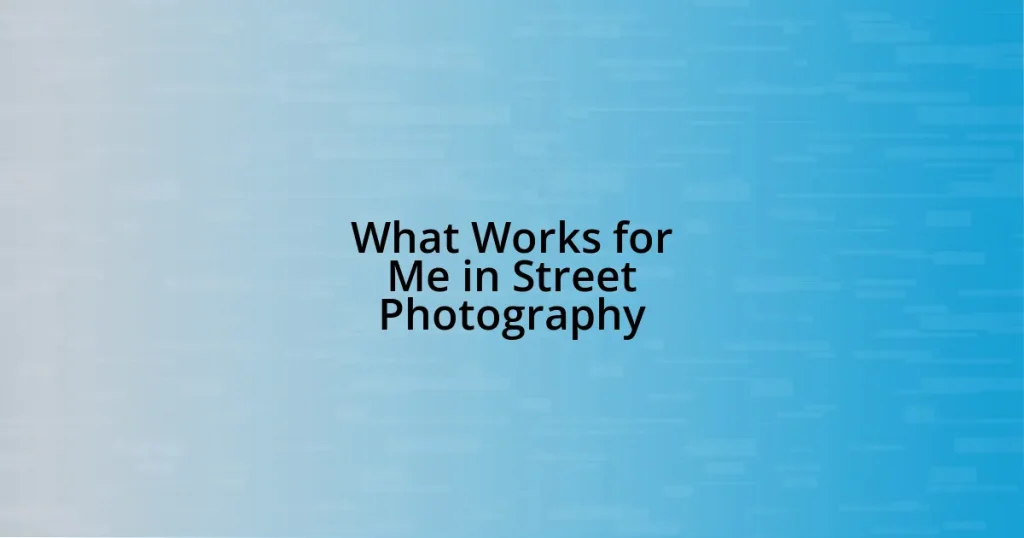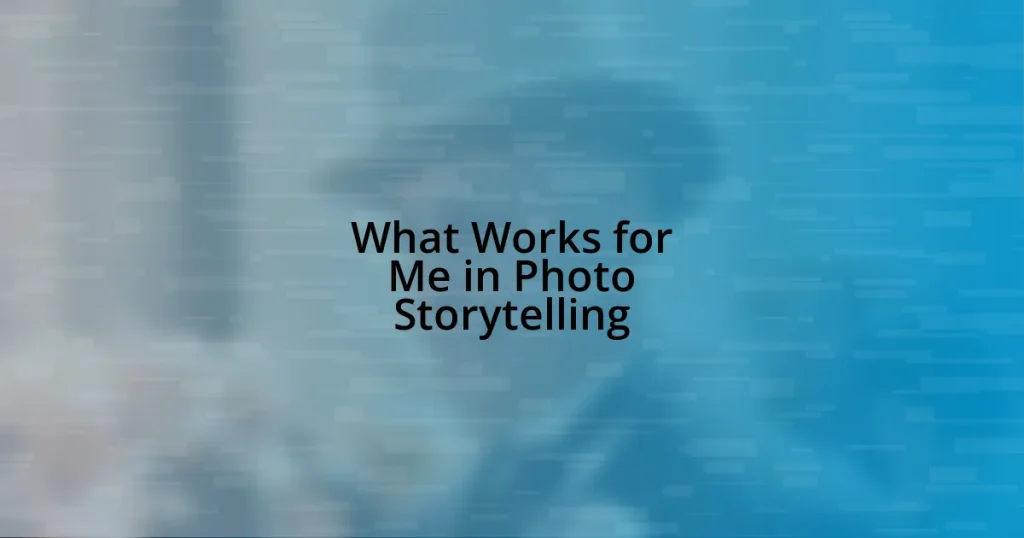Key takeaways:
- Landscape photography conveys emotion, capturing the beauty and unpredictability of nature.
- Essential tools include a sturdy tripod, wide-angle lenses, and filters to enhance compositions and ensure stability.
- Techniques like the rule of thirds, long exposure, and incorporating foreground interest are vital for compelling images.
- Post-processing enhances images by adjusting exposure, clarity, and composition to better reflect the photographer’s vision.

Understanding Landscape Photography
Landscape photography is more than just capturing a beautiful scene; it’s about conveying the emotion of a moment in nature. I remember standing on the edge of a cliff at sunset, the sky painted in hues of orange and purple. It was in that moment I realized how a photograph can evoke a feeling of tranquility or even awe.
Understanding landscape photography means recognizing the elements that make a composition compelling. What drew me to this genre was the challenge of balancing light, color, and foreground interest. I’ve often found myself questioning, how can I make this image not just stunning, but also tell a story? That inquiry drives my creativity and helps me craft images that resonate with others.
Every landscape presents its own challenges, from difficult weather conditions to unexpected wildlife encounters. I still recall an early morning when fog rolled in, obscuring my view. Instead of feeling defeated, I embraced the atmosphere, capturing ethereal images that transformed the ordinary into the extraordinary. It’s moments like these that deepen my appreciation for the unpredictability of nature and the art of photography.

Tools for Landscape Photography
When it comes to landscape photography, having the right tools can profoundly influence your results. Personally, I’ve learned that while creativity plays a crucial role, the equipment used can make a significant difference in achieving that perfect shot. For instance, I invested in a sturdy tripod during a trip to the national parks. The stability it provided allowed me to experiment with long exposures, capturing the gentle flow of a waterfall that still resonates with me.
Here are some essential tools that every landscape photographer should consider:
- Camera Body: A reliable DSLR or mirrorless camera for high-resolution images.
- Lenses: A wide-angle lens is essential for sweeping vistas, while a telephoto lens can capture distant details.
- Tripod: Stabilizes your camera for long exposure shots in low light.
- Filters: Neutral density and polarizing filters can help control reflections and enhance color saturation.
- Remote Shutter Release: Reduces camera shake and allows for long exposure photography.
- Extra Batteries and Memory Cards: Ensures you’re prepared for long shooting sessions without interruptions.
I’ve found that these tools don’t just support my technical needs but also inspire my artistic vision. Whether it’s the sound of the shutter clicking away or adjusting my filters to capture that perfect light, I cherish the connection between my equipment and the moments I aim to freeze.

Techniques for Capturing Landscapes
Capturing landscapes is as much about technique as it is about intuition. One technique I always keep in mind is the rule of thirds. This simple yet powerful guideline assists in placing the focal point of my image at the intersection of imaginary lines, creating a more balanced composition. I remember experimenting with this while photographing a coastal vista at dawn; the placement of the horizon aligned perfectly with one of the lines, which truly enhanced the visual impact of the scene.
Another fundamental technique I’ve embraced is long exposure photography. By using a neutral density filter, I can extend my exposure time, allowing me to capture the silky movement of clouds or water. I recall a gorgeous sunset where the waves gently kissed the shore, and as I adjusted my shutter speed, the resulting image transformed the chaotic surf into a serene, dreamlike landscape. This technique not only adds depth but often evokes a sense of calm.
Lastly, focusing on foreground interest has become a priority in my landscape photography. Including interesting elements in the foreground draws the viewer’s eye into the image and provides context. One memorable shot involved a weathered log lying on a rugged beach, which led the viewer’s gaze to the dramatic cliffs in the background. I always aim to create a visual journey through my photographs, inviting the audience to delve into the beauty of the landscapes I encounter.
| Technique | Description |
|---|---|
| Rule of Thirds | Enhances composition by placing focal points at intersecting lines to create balance. |
| Long Exposure | Captures motion (like water and clouds) using a neutral density filter to achieve silky, dreamlike effects. |
| Foreground Interest | Incorporates elements in the foreground to create depth and draw viewers into the landscape. |

My Challenges in Landscape Photography
Landscape photography has its fair share of challenges, and I’ve found that one of the most significant is dealing with unpredictable weather. I can’t count the times I’ve arrived at a stunning location only to be met with gray skies and heavy rain. It can be incredibly frustrating to pack your gear, hike for hours, and then watch the perfect lighting vanish behind dark clouds. Yet, I’ve also learned that embracing these moments can lead to unique shots—like capturing a moody landscape with dramatic lighting that shifts in an instant, creating an atmosphere rich in emotion.
Another hurdle I’ve encountered is the sheer amount of time it takes to scout and plan my shots. There are days when I’ve spent more hours wandering the terrain than actually shooting. Sometimes I ask myself—am I wasting time? But those explorations have taught me the importance of patience. I once spent an entire afternoon hiking through a forest, feeling disheartened when I didn’t find the perfect viewpoint. However, as the light changed, I stumbled upon a hidden clearing that offered a breathtaking view just in time for sunset. That unplanned moment became one of my favorite photographs.
Lastly, composition can be a tricky beast to tackle. There are moments when I instinctively see a beautiful scene, yet translating that vision into a compelling photograph feels nearly impossible. I recall a time when I struggled to frame a majestic mountain range because everything seemed so vast. It’s in these moments of self-doubt that I remind myself—every great photographer has been here. I took a breath, reassessed my angles, and eventually captured a shot that brought the grandeur of the landscape into focus. This experience reinforced my belief that challenges are pathways to growth, and they often lead to the most rewarding images.

Post Processing Landscape Images
Post-processing is where I’ve found a canvas to really amplify the beauty of my landscape images. Using software like Lightroom, I enjoy adjusting the exposure and contrast to breathe life back into a scene. For instance, there was a time when I shot a dramatic sunset, but the colors didn’t pop as expected. A few tweaks to the saturation and vibrance made those hues dance across the image, transforming it into something that mirrored my experience of standing there in awe.
I also play with texture and clarity to enhance the details. In one memorable shot of a rugged mountain trail, the rocks appeared flat in their initial form. By increasing clarity, I was able to accentuate those textures, giving the entire scene more depth and making the viewer feel as if they could reach out and touch the landscape. Don’t you find it fascinating how small adjustments can significantly alter the viewer’s perception?
Lastly, the art of cropping shouldn’t be underestimated. I’ve learned that sometimes, the strongest composition lies in removing distractions. I once captured a serene lake but found my eye drifting to some clutter in the corners. After cropping, the focus became solely on the calm waters mirroring the mountains above, allowing the viewer to truly appreciate the tranquility of the moment. When does one picture become a blank canvas, ready to reveal a deeper story? It’s in those moments of reflection during post-processing that I can truly craft the narrative I wish to share.

Lessons Learned Through Photography
Photography has taught me more than just technical skills; it has shown me the value of patience. There was a time when I trekked for hours, hoping for a breathtaking sunrise. As dawn broke and the sky lit up, I realized that those moments of waiting often reward you with the most stunning visuals. Don’t you think in life, just like in photography, the best things often come to those who wait?
I’ve also learned to embrace spontaneity through my lens. One summer evening, while setting up my shot of a tranquil river, I noticed a family of ducks glide into the frame. Instead of getting frustrated that my original shot was disrupted, I adjusted my focus. That unexpected moment became one of my favorite captures, reminding me that some of life’s best memories are unplanned. Isn’t it interesting how flexibility can lead to the most memorable experiences?
The importance of perspective has been another critical lesson for me. I vividly remember crouching low to the ground, trying to capture wildflowers in a vast field. Initially, I was focused on the flowers alone, but then I changed my angle and included the stunning sunset in the background. That shift transformed the photograph, amplifying the sense of scale and beauty. I often wonder, how many opportunities do we miss simply because we refuse to change our perspective?

Future Goals in Landscape Photography
One of my future goals in landscape photography is to venture into more remote locations. I’ve found that the most breathtaking landscapes often require a bit of effort to reach. I recall my exhilarating hike to a hidden valley, where the untouched beauty made every step worth it. The idea of discovering similar gems fuels my passion. Have you ever felt the thrill of standing in a place few have witnessed? It can be transformative.
I also aspire to deepen my understanding of natural lighting. I remember a day spent on a windswept cliff trying to capture the golden hour. The light seemed fickle, shifting rapidly and playing tricks on my settings. That experience sparked a desire in me to study lighting more intently. How can one light source inspire countless moods? I want to explore that question with every capture.
Lastly, I aim to experiment with new techniques and styles. Recently, I experimented with long-exposure photography during a calm evening at the beach. The silky water and cloud movement created a surreal effect that took me by surprise. This opened my eyes to the endless possibilities within landscape photography. What if I combined techniques I haven’t yet tried? The thought excites me, pushing me towards creativity beyond my current comfort zone.
















